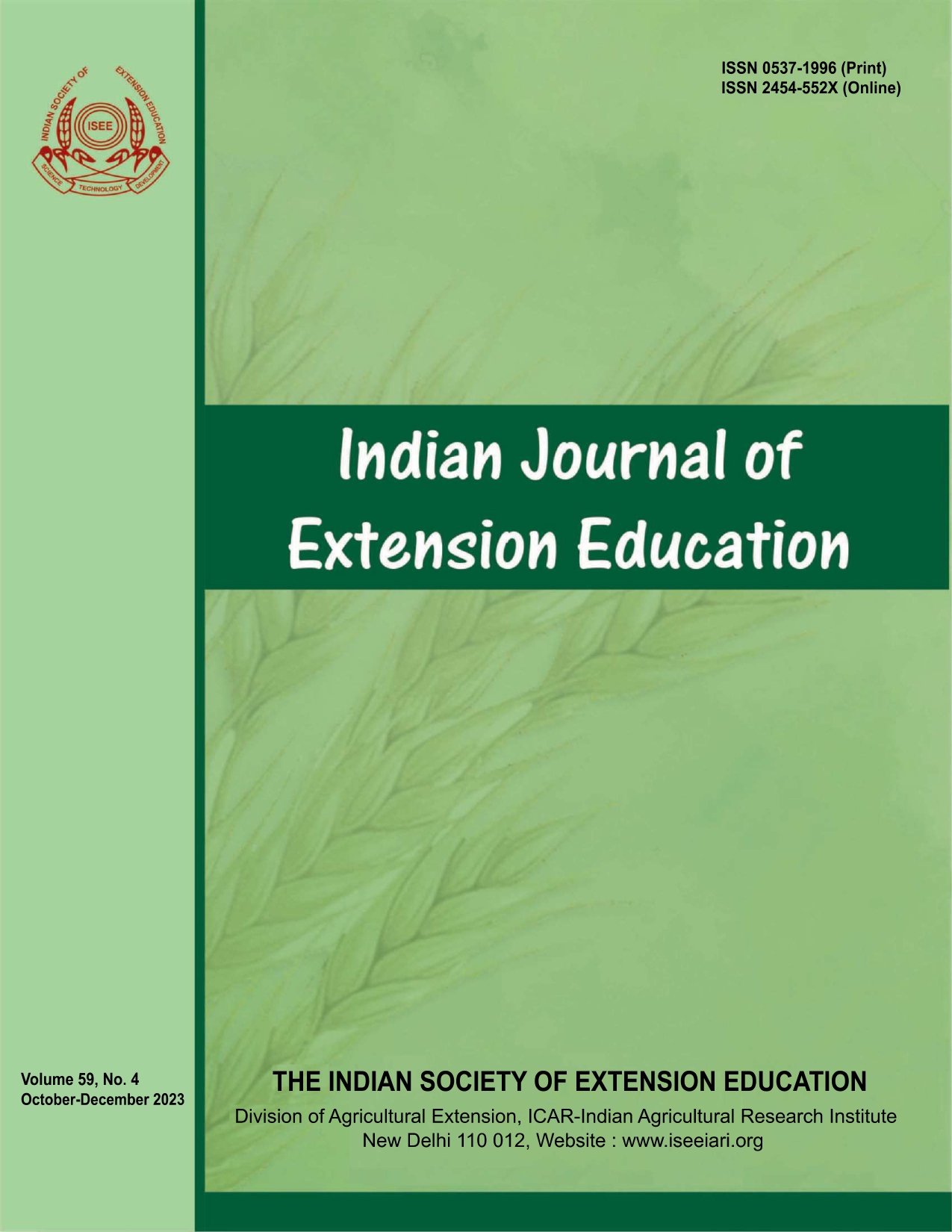Knowledge Level of the Farmers about Hybrid Rice Cultivation in Jammu District
DOI:
https://doi.org/10.48165/IJEE.2023.59424Keywords:
Knowledge level, Hybrid rice, ANOVA, Cultivation practicesAbstract
Hybrid rice technology is crucial for securing the food security of the burgeoning population of India. The study carried out in 2021 aims to assess the knowledge level of farmers regarding hybrid rice technology. Three specifically chosen sub-divisions of Jammu District; Marh, Akhnoor, and R.S. Pura, having the cultivation of hybrid rice and using the proportionate and purposive random techniques 38 from R.S. Pura, 13 from Akhnoor and 99 respondents from Marh, making a total sample size of 150 hybrid rice growers. A standardized knowledge test with reliability 0.86, was developed for assessing the knowledge level of hybrid rice growers. The Cube root method was applied to devise different knowledge categories of hybrid rice growers, which varied from medium to high. According to the results of the ANOVA test, there was no discernible difference between the knowledge levels of hybrid rice growers in the three sub-divisions.
Downloads
References
Bhatt, R., & Singh, P. (2022). Farmer’s field evaluation of direct seeded rice vis-à-vis puddled transplanted rice in Kapurthala, Punjab. Indian Journal of Extension Education, 58(2), 42-46.
Blandford, D. (2011). The Contribution of Agriculture to Green Growth. https://www.oecd.org/greengrowth/sustainable-agriculture/ 48258861.pdf
Bloom, D. S., Engelhart, M. D., Furst, E. F., Hill, W. H., & Krathwohl, D. R. (1956). Taxonomy of Educational Objectives, David Mckay Company INC, America.
Chandawat, M. S., Sharma, P. K., Patel, J. K., & Parmar, A. B. (2018). Knowledge of the farmers of Kheda district in Gujarat about improved cultivation practices of kharif rice crop. International Journal of Farm Sciences, 1(1), 126-131.
Davis, K. E. (2008). Extension in sub-Saharan Africa: Overview and assessment of past and current models, and future prospects. Journal of International Agricultural and Extension Education, 15(3), 15-28.
Digest of Statistics 2018-19., Directorate of Economics and Statistics of Jammu and Kashmir, Jammu and Kashmir.https://ecostatjk.nic. in/pdf/publications/digeststat/2018-19.pdf
Fisher, R. A. (1958). Statistical methods for research workers (13thed.). Edinburgh: Oliver and Boyd. https://books.google.co.in/books/ about/Statistical_Methods_For_Research_Workers.html?id=4b TttAJR5kEC&redir_esc=y
Gogoi, J., Buragohain, R., & Deka, N. (2022). What motivates rice farmers to adopt hybrid rice technology in Assam, India, Indian Journal of Extension Education, 58(3), 74-77.
Iqbal, C. M. (2021, July 20). Message from director. http://diragrikmr. nic.in/index.html
Kshash, B. H. (2018). Knowledge level of rice farmers regarding cultivation practices in Mahanawiyah district, AL-Qadisiya province, Iraq. International Journal of Agricultural Science, Research and Technology in Extension and Education Systems, 8(2), 71-78.
Meena, S. L., Lakhera, J. P., Sharma, K. C., & Johri, S. K. (2012). Knowledge level and adoption pattern of rice production technology among farmers. Rajasthan Journal of Extension Education. 20, 133-137.
Nagmani, P. R., Jyothi, V., & Gopal, P. V. S. (2023). An analysis of knowledge and adoption of critical crop interventions in rice cultivation by tenant farmers in A.P. Indian Research Journal of Extension Education, 23(1), 69-74.
Pradeep, K., Prakash, K., & Mishra, O. P. (2013). Comparative study on knowledge level of marginal and small farmers about rice production technology. Indian Research Journal of Extension Education, 31(1), 85-90.
Prasad, D., Bareth, L. S., Jhingoniya, H. K., Keshri, A. K., & Sharma, S. (2015). Knowledge level of farmers about improved rice cultivation technology. Indian Research Journal of Extension Education, 51(3&4), 108-111.
Prusty, A. K., Panigrahi, R. S., Padhy, C., & Rout, S. (2020). Knowledge level of farmers regarding system of rice intensification (SRI) method in Puri district of Odisha, Indian Journal of Pure and Applied Biosciences, 8(3), 270-277.
Rahangdale, P. K., Bose, D. K., & Patle, C. (2018). Knowledge level of hybrid rice among farmers in Balaghat district. Indian Journal of Extension Education, 54(3), 160-162.
Rejula, K., Singh, R., & Nain, M. S. (2017). Rice farming for food security and ecological sustainability: An analysis of farmers’ awareness in Kerala. Indian Journal of Extension Education, 53(4), 101-106.
Rout, D., Jena, D., Singh, V., Ahlavat, M. K., Arsode, P., Singh, P., Katara, J. L., Samantaray, S., & Verma, R. (2020). Hybrid rice research: Current status and prospects. In: Ansari, M.R. (Eds.), Recent Advances in Rice Research. Intech Open pp 1-23.
Sarma, P. K., Alam, M. J., & Begum, I. A. (2022). Farmers’ knowledge, attitudes, and practices towards the adoption of hybrid rice production in Bangladesh: an PLS-SEM approach, GM Crops & Food, 13(1), 327-341.
Shah, K. A., Tandel, B. M., Nayaka, P., & Timbadiya, C. K. (2016). Knowledge levels and adoption pattern of rice production technology among the Navsari district farmers. Agriculture Update, 11(3), 242-246.
Sharma, K., Dhaliwal, N. S., & Rampal, V. K. (2017). Farmers’ knowledge towards aerobic rice cultivation in Muktsar District of Punjab. Indian Research Journal of Extension Education, 17(4), 83-86.
Singh, R. (1975). On optimum stratification for proportional allocation. Sankhya, 3(7), 109-115.
Singh, D., Nain, M. S., Hansra, B. S., & Raina, V. (2011). Trends in non-basmati rice productivity and factors of yield gap in Jammu Region. Journal of Community Mobilization and Sustainable Development, 6(1), 59-64.
Sreenivasulu, N. (2022, July 1). IRRI at a glance.https://www.irri.org/ hybrid-rice
Statista. (2021, July 12). Worldwide Production of Grain in 2020/21, by type (in million metric tons). https://www.statista.com/ statistics/2639 77/world-grain-production-by-type/
USDA. (2021, September 20). Rice Sector at a Glance. https:// www.ers.usda.gov/topics /crops/rice/rice-sector-at-a-glance/ Van den Ban, A. W., & Hawkins, H. S. (1996). Agricultural extension
(2nd ed.), J.S Offset Printers, Delhi. p 17. https://www.worldcat. org/title/agricultural-extension/oclc/34320593
Published
Issue
Section
License

This work is licensed under a Creative Commons Attribution-NonCommercial-NoDerivatives 4.0 International License.


